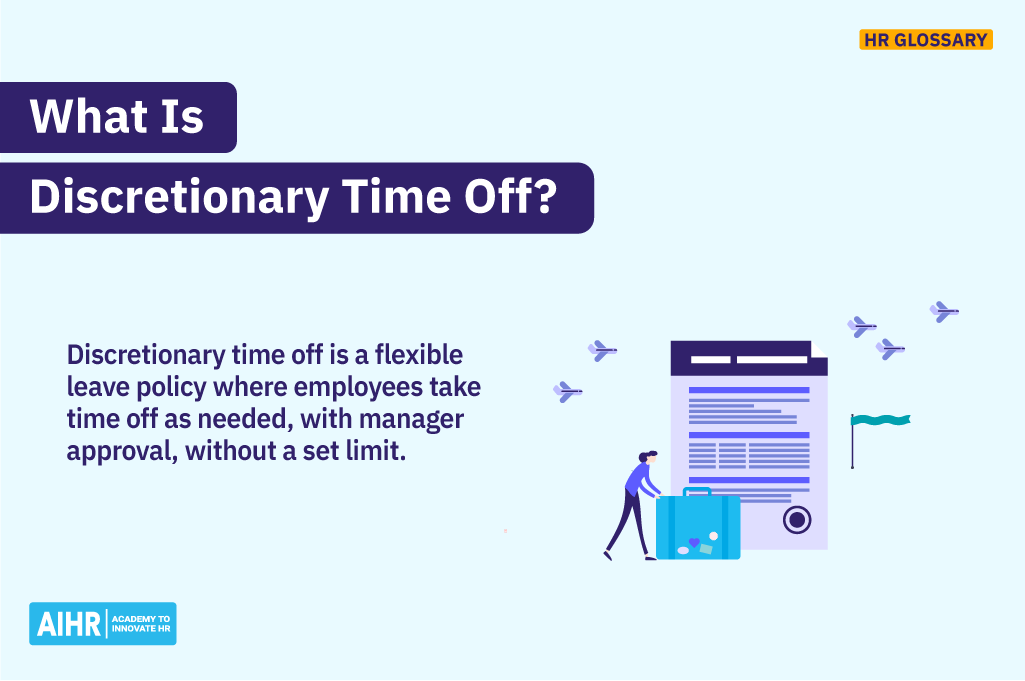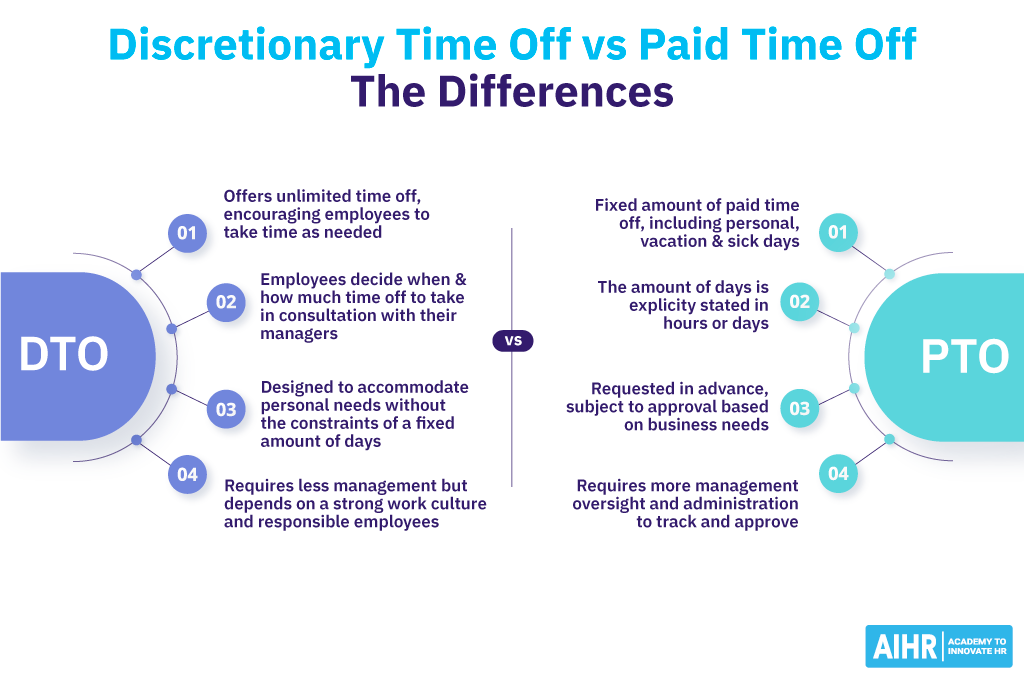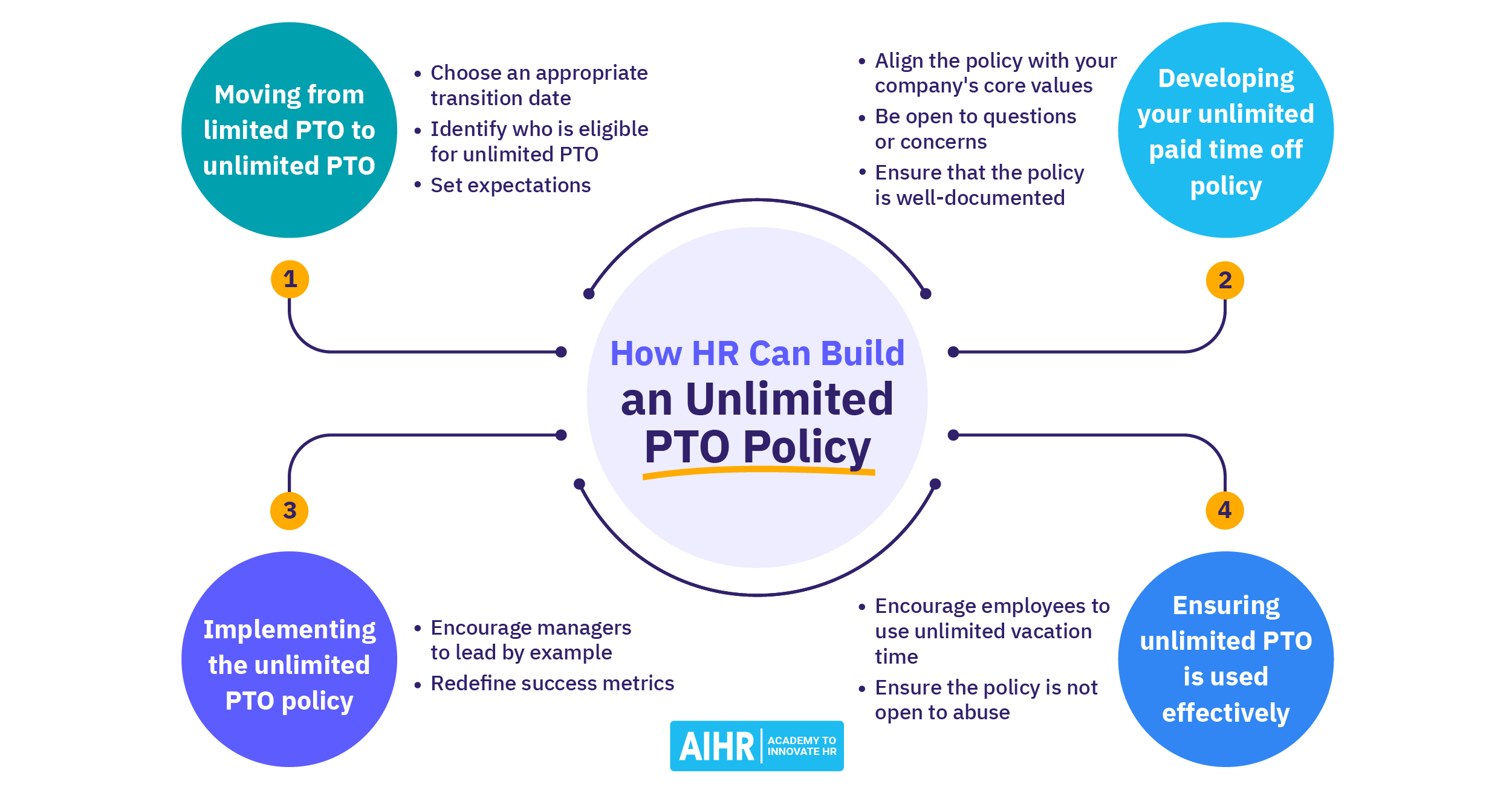Discretionary Time Off
What is discretionary time off?
Discretionary time off (DTO) is a leave policy that allows employees unlimited paid time off each year. This system provides staff with the flexibility to take leave as needed – whether for vacation, appointments, or other personal matters. While DTO does not impose strict limits, it often includes recommended guidelines, such as limiting consecutive weeks off.
Depending on the company, an employee may need to get prior approval to take discretionary paid time off. Approval may depend on the number of days requested and the company’s needs. Unlike traditional vacation day policies, employers don’t pay back employees for any unused DTO when they leave the company.

Examples of discretionary time off
Examples of discretionary time off policies can vary based on company culture and industry, but here are a few ways organizations implement them:
- Tech companies offering flexible leave: Many technology firms, such as Netflix, offer discretionary leave where employees are trusted to take the time they need without strict limits. Employees coordinate with their managers to ensure projects stay on track while taking personal or vacation days as necessary.
- Creative agencies with seasonal workloads: Marketing and advertising agencies sometimes implement DTO, where employees can take breaks during slower periods while being available during peak project times.
- Remote-first companies: Organizations that operate with fully remote teams may use DTO to allow employees to manage their own schedules and take time off based on workload and personal needs, ensuring flexibility across different time zones and working styles.
- Startups with unlimited PTO approaches: Some startups implement DTO to attract talent and promote a culture of flexibility. Employees are encouraged to take time off as needed, with an emphasis on work-life balance, rather than adhering to rigid accrual systems.
Discretionary time off vs. paid time off
There are important distinctions between discretionary time off and paid time off (PTO). Here are some key differences:
Definition
No limit on the number of paid time off per year.
Fixed amount of paid time off, including vacation, sick days, etc.
Planning and approval
Generally, employees take paid time off when needed, and there are minimal approval process.
Depending on the type of leave, formal requests and approvals are usually needed.
Tracking
Less emphasis on tracking the exact number of days taken.
Detailed tracking of accrued and used days.
Management style
Relies on trust between managers and employees.
Employers monitor employees’ use and compliance.
Suitability
Works well in high-trust and flexible working environments.
Best suited for companies with structured processes.

Benefits of discretionary time off
Some of the key benefits of offering discretionary time off are:
- Reduced administration: Discretionary time off policies can reduce the administrative duties of tracking vacation accruals. It also simplifies the process and management of time-off requests, leaving it up to the employee and manager.
- Increased job satisfaction: Allowing employees more control over their time off creates a sense of empowerment and trust. This autonomy not only boosts morale but also cultivates a more positive and engaged workforce.
- Better work-life balance: A key component of DTO is the discretion to take time off when needed. For many employees, this allows them to better balance work and personal/family needs.
- Improves talent attraction and retention: Companies that offer discretionary time off are often more attractive to potential employees. This benefit can foster greater wellbeing, which is a competitive advantage for attracting and retaining top talent.
Drawbacks of discretionary time off
Despite the benefits, DTO does have some drawbacks, including:
- Employee misuse: Some employees may take advantage of a DTO policy by taking an unreasonable amount of time off. This misuse can create mistrust and negatively impact team dynamics and overall productivity.
- Inequality in usage: Certain job roles have greater flexibility than others, leading to unequal use of discretionary time off across an organization. Employers must ensure all employees have equal access to DTO.
- Negative impact on team dynamics: Discretionary time off can lead to unpredictability in scheduling. If many employees decide to take time off simultaneously, it can disrupt workflow and project timelines.
- No payout on termination: While this can be cost-effective for the company, employees might feel shortchanged if they leave without any compensation for unused time off, unlike traditional accrued vacation policies.
Discretionary time off policy: What to include
Before implementing a DTO policy, it is crucial to consider its potential impact on employees and the entire organization. Here are some ways you can design a successful discretionary time off policy:
- Establish clear guidelines: Provide a comprehensive overview of the organization’s DTO policy. Guidelines should clearly define what DTO means and how it differs from other types of leave (e.g., family leave, medical leave, etc.). Outline the procedure for planning, requesting, and approving DTO.
- Specify eligibility: Identify which employees are eligible for discretionary paid time off. In the U.S., DTO is primarily offered to salaried exempt employees (and not to hourly non-exempt employees). Some companies, like Microsoft, only offer DTO to U.S.-based employees because of legal and regulatory differences in other countries.
- Provide guidance and training: Clearly outline employee responsibilities for using DTO, such as advanced notice, workload cover, the maximum amount of consecutive days, etc. HR should also ensure managers receive training on managing DTO requests, providing guidance on maintaining productivity during employee absences.
- Pilot the policy: Conduct a pilot program with a smaller group of employees and managers to test the policy. HR teams should monitor, track, and gather feedback on the usage of DTO and adapt the policy where needed.
- Ensure legal compliance: Before rolling out your DTO policy, ensure compliance with the employment laws and regulations of your country. Discretionary time off does not replace mandatory leave requirements such as family, medical, and parental leave.
- Carefully monitor: Continuously assess and monitor the effectiveness of the DTO policy. Utilize surveys and focus groups to collect feedback from employees and managers to assess usage, impact, and satisfaction with the policy. This proactive approach can help you modify or even terminate DTO.
HR tip
A successful DTO policy depends on trust and open communication between employees and managers. HR professionals can support open discussions of discretionary time off by encouraging it during regular check-ins and ongoing performance management.
FAQ
Discretionary time off (DTO) is a flexible leave policy that allows employees to take time off as needed, without a fixed number of days, as long as their work responsibilities are met and their manager approves. This approach offers greater flexibility compared to traditional paid time off (PTO) policies.
The approach to compensating DTO can differ from one company to another. In most cases, employees continue to receive their usual salary during DTO periods.
The terms DTO and unlimited PTO are often used interchangeably, but there are some key differences in their overall philosophy. DTO emphasizes allowing employees to choose when to take time off without a specific limit. On the other hand, unlimited PTO focuses on “outcome-driven results.” An employee can take time off without a predetermined limit as long as they meet their workload demands and performance expectations.









